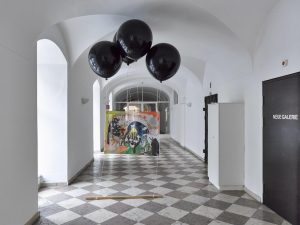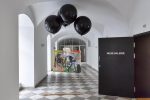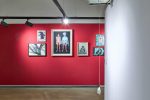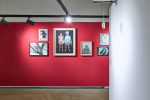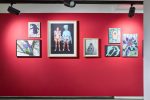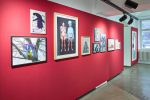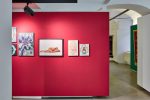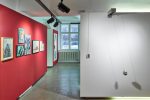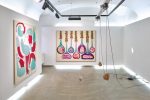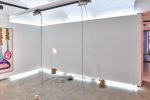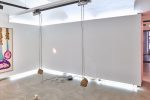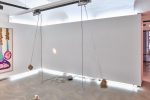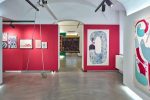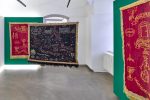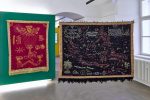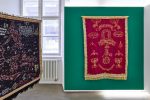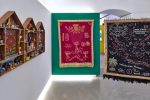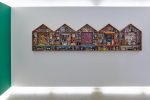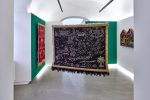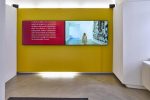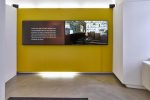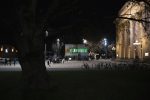PLEASURE ACTIVISM
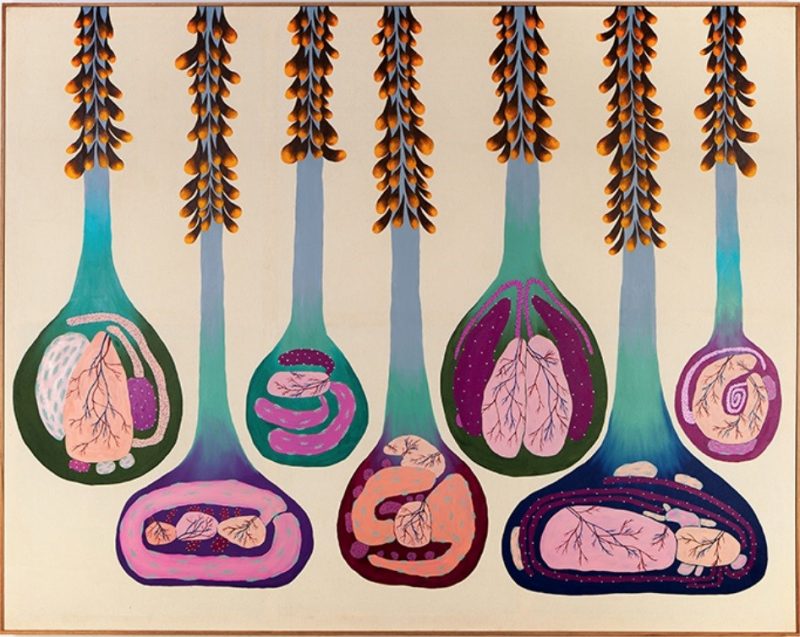
PLEASURE ACTIVISM
Ariel Efraim Ashbel | Cian Dayrit | Anne Duk Hee Jordan | Sophia Süßmilch
Curated by Petra Poelzl
RE-OPENING 10.02. – 17.04.2021
———————————————————
Pleasure is a feeling of happy satisfaction and enjoyment. Activism consists of efforts to promote, impede, or to direct social, political, economic, or environmental reform or stasis with the desire to make improvements in society. Pleasure activism is the work we do to reclaim our whole, happy, and satisfiable selves from the impacts, delusions, and limitations of oppression and/or supremacy.
adrienne maree brown | Pleasure Activism | p. 13.
Based on adrienne maree brown’s publication Pleasure Activism, the exhibition of the same name shows creative works that refuse to accept social and political power relations, open up multifaceted, pleasurable worlds of images and narratives, and thus begin to disturb established ways of seeing and thinking. The author, adrienne maree brown, writes from the perspective of a black feminist and so from an intersectional standpoint, which means the interaction of various forms and dimensions of inequality, difference and power. In this constellation of power relations, certain characteristics are privileged, while others are discriminated against. In order to abolish this dominant construct, the author proposes to anchor “pleasure” in our social structures and thus in our daily lives.
Pleasure Activism asserts that we all need and deserve pleasure and that our social structures must reflect this. In this moment, we must prioritize the pleasure of those most impacted by oppression.
adrienne maree brown | Pleasure Activism | p. 13.
At first glance, the exhibition in the Neue Galerie also aims to celebrate “pleasure”, presenting as colorful, gaudy, lustful and playful. At second glance, however, the artistic positions invited by Petra Poelzl call for a conscious approach to existing power structures and seek to dissolve them, make them visible, and put them up for discussion. The artistic works achieve this in political, poetic, activist, humorous or abstract ways – and thus create fields of imagination and possibility that invite us to immerse ourselves in new ways of seeing as well as offering fresh scope for action.
ANNE DUK HEE JORDAN
In the entrance area of the Neue Galerie, the print of a drawing floats on three black balloons, but does not quite manage to leave the ground because a piece of wood is pulling it down. The drawing thus finds itself in an intermediate space, between weightlessness and gravitational force. HERR DER KRÄHEN | LORD OF THE CROWS (2020) is one piece of a set designed by Anne Duk Hee Jordan at the jtw Spandau (Berlin). The production is based on the novel of the same name by the Kenyan writer Ngugi wa Thiong’o, which is a comprehensive parable of the social, political and cultural conditions on the African continent and its relationship to the West. In the novel, the ruler of the fictional country of Aburiria intends to build a huge monument to connect heaven and earth. When this ruler travels to the USA to borrow money from the Global Bank for the construction, he is surprised by a mysterious illness; he inflates like a balloon, and he has been suspended below the ceiling ever since. No doctor can help him – only the “Lord of the Crows”, who has magical powers and has achieved fame as a healer and fortune teller.
HOW TO KNOCK A NAZI DOWN (2016) is a kinetic stone pendulum, which initially appears minimalist in form. Through interaction with the audience, however, it quickly develops a life of its own. If you press the button on the left side of the pendulum, it launches into a choreographed sequence of movements. The title should not be understood in its literal sense. In her artistic practice, Anne Duk Hee Jordan repeatedly approaches explosive contemporary issues in a humorous way and so gives her audience something to think about.
(…) To me, art [is] one of the most important media to be able to change the circumstances of a social or political form. I find that very important. And I also think it’s important to remain open and to communicate. If you can’t do it on a large scale, then you should do it on a small scale, with the people you deal with directly. I think that’s the only way things can change.
Anne Duk Hee Jordan in an interview with Chrischa Oswald | Collectors Agenda (Original text in German)
ENTANGLEMENT (2015) is also part of Anne Duk Hee Jordan’s series of kinetic sculptures. This is a large pendulum with two arms, hanging from a construction on the ceiling, each ending in a volcanic rock. Since the pendulum is connected to a motion detector, visitors also need to become active in this work. If you move towards the pendulum at the correct angle, therefore, the two arms begin to swing. At first, the arms move away from each other – until the maximum distance of 4 metres is reached. Then, the rocks begin to move towards each other so quickly that the semblance of a possible collision is generated. Although the speed of this repetitive routine movement increases progressively, the rocks never touch. It seems as if Jordan has tamed two volcanic rocks in order to capture intimacy and rejection, attraction and fear, the present and infinite time, in a performative moment.
Our radical imagination is a tool for decolonization, for reclaiming our right to shape our lived reality.
adrienne maree brown | Pleasure Activism | p. 10.
SOPHIA SÜßMILCH
Sophia Süßmilch’s artistic output is as fast-paced as the digitalized present. Her paintings and self-portraits are parallel worlds that dissect patriarchal structures in order to reconstruct them in a humorous, brightly-colored manner. The Süßmilch ocean is infinitely deep and full of idiosyncratic creatures that drive the worldview of the global North into the wall with a crash and a bang. In an almost orgiastic mix of colors and shapes, a pleasantly warm feeling of connection settles in as we dive into this ocean. Pleasure galore!
The exhibition presents a series of smaller and large-scale paintings as well as photographs, in which Süßmilch herself can be seen with some of her partners in crime. Titles such as Selbstportrait als Bundesadler (Self-Portrait as Federal Eagle), Drogenfresserchen (Little Drug Eater,) Sugar Mama or Placenta Paradise speak a clear language and reveal worlds that have liberated themselves from hegemonic patterns and structures.
The existence of the living body is the logical precondition to any kind of art production or: MORE BEAUTIFUL FAILURE
Extract | Artistic Statement | Sophia Süßmilch
Among all the comments about my artistic work, this one has been the most pleasing to me so far: “I saw your work, and I was so relieved afterwards.”
The sensation of relief is one of the best feelings we ever experience in life. Relief from the pressures and weight of existence that unexpectedly disappear from one’s shoulders for a moment, accompanied by amazement that art can do this: find and interpret connections in a seemingly chaotic world; a possible explanation for questions and puzzles, generated from novel connections in a previously non-existent, powerful image.
I have dropped any claim to technical perfection and ingenious originality. Instead, I trust in the naive notion of artistic production as a process of self-discovery in the shape of ongoing, uncensored creation, accompanied by pleasure in what I do. Instead of an academically disciplined role, I follow my impatient temperament and character, and when everything has to be done quickly, I accept the conflict between quality and quantity.
Showing the flood of ideas and thoughts seems more important to me than elaboration, and freedom from the constraints of art production lies in this for me; the sheer quantity overcomes the internalized critical instance. This is how I define permanently the relationship between myself and my environment, between things: perhaps as a visually-aesthetically and physically-emotionally experienced relief for those who are unable to walk this type of path, whose bodies are caught fast in other lives.
For what is there at the very beginning, if not the body? My body, the physicality of us all. The body is always there, no matter where you go. If it is no longer there, we are no longer there, disembodied and emptied. It determines our relationship to the world, to all other bodies and things. As the shell and the representative of the spirit and the ego, the origin of our being in the world, it is the primary starting point of my art. In the body, I see myself as a moving sculpture, as a playful tool.
I chop up, digest my impressions and then bring them up again, in an act of regurgitation, towards confrontation with the world and other people. I name the work: it is what it is, I take the burden of thought from you. And yet, provided with playfully found titles, the combination of words and images liberates itself from the constraints of unambiguity. It is what it is and a thousand other things at the same time. I am always concerned with hope, in humorous mode, sometimes escapist and angry, a sigh of relief from weighty, necessary discourses: poetry and the anarchy of idiocy. A tragicomic moment. An oscillation between ironic distance and aggressive proximity. My body, the body of a woman, must still be understood and conceived of politically. My work with myself has a feminist side effect. Between performance and video, photography and painting, I explore the parameters of my expression and those of its reception experimentally, questioning and challenging people’s understanding of art. Making art as if it were about my life, because that’s what it’s all about – life. In doing so, I can and perhaps will inevitably fail, in a world of overwhelming simultaneities and imbalances. But if that’s how it has to be, at least there’s beautiful failure: wanting everything, not being able to do anything. Continuing as resistance. My art, it’s whistling in the dark.
Sophia Süßmilch
CIAN DAYRIT
Historically, maps have always served as a panoptic technology to guide, discipline and control on behalf of imperial powers. Their visualisations have reinforced the dominance of colonialist rulers while contributing to the marginalization of entire regions and peoples.
WE MOVE AMONGST GHOSTS (2019) is an informational graphic in the form of an embroidered map that names the indigenous peoples, the most marginalized communities of the liberation movements in the Philippine archipelago. Peasant and indigenous communities have always been at the forefront of liberation struggles to escape Western colonization for imperialist plundering. In the ornate frame of the cartography on the textile work–translated from Tagalog, the most widely spoken language in the Philippines–is the phrase “For the archipelago of Southeast Asia and its indigenous groups”. On the opposite side we read: “In solidarity with the struggle for self-determination and freedom, escaping the clutches of the fascist regime and neoliberal policies”.
TERRA RATIONARIUM (2018)
Five wooden display boxes arranged in a row contain everyday and found objects. Symbolisms of supranational contexts are inherent in them, and so they represent exploitative practices of hegemonic and neo-imperial powers. While in the past it was Spain and the USA, currently it is China and international island tourism that enslave the Philippines by means of mineral extraction, monoculture, cheap labor, land theft or militarization in a neo-colonialist exploitative campaign.
Described by postcolonial scholars as science laboratories and tourist destinations, the islands in our archipelagoes serve as inexhaustible supplies of raw, extractable materials for the modernist occupiers, explorers and colonizers who saw nature as exploitable all in the service of capital.
Excerpt from the exhibition text by Prof.Joseph Palis for the exhibition “No Man’s Land”
Tin-Aw Art Gallery, Makati, Manila, 2018.
In the two-part textile work ADVERSUS CONTRADICTORES I & II (2019), Dayrit draws on the spiritual and revolutionary visual vocabulary of the Anting-Anting while exposing the imperial legacy of the “white saviour” and its martial tactics. In Tagalog, Anting-Anting refers to a system of spirituality and magic to which great importance is attributed in the Philippines. Symbols from this system are embroidered into handkerchiefs and serve as talismans to protect the wearer from harm. Embroidered on red fabric, the work shows symbols from the Anting-Anting, which stand next to imaginary iconographies and Latin terms such as “Principatus” or “Institutum”. Dayrit thematizes the arrival of the Spaniards in 1521 with this interplay, as well as the concomitant conversion of the Filipino population to Roman Catholicism. The animistic practices, the traditional belief in spirits and magic were not completely eradicated by the arrival of the Spanish missionaries, but merged with Catholic doctrine to form a religion. A religious syncretism emerged, which is still prevalent in the Philippines today.
ARIEL EFRAIM ASHBEL
The Phenomenology of Disappearance (2020) is an interdisciplinary experiment oscillating between film, sculpture and music theatre. Ariel Efraim Ashbel conceived it together with the composer Maya Dunietz for the festival, Mannheimer Sommer. The work was filmed in the exhibition spaces of the Kunsthalle Mannheim. For the exhibition “Pleasure Activism”, Ashbel develops the work further and interweaves the existing video with text passages from the libretto into a two-channel video.
The starting point of the video work was the Phenomenology of Spirit (Phänomenologie des Geistes) by Georg Wilhelm Friedrich Hegel (1770-1831) and the essential motif of master and slave to be found in this philosophy. Hegel regarded this dialectic as the source of self-consciousness, as the source of identity – a consideration whereby the Other constitutes the Self. Hegel is one of the highly acclaimed German thinkers and philosophers who harbored an outspoken anti-Semitism and racism in their works.
He combines his views on origin, race, culture and imperialism into a thesis that says: the highest level of human development is the nation state. And he deduces from this that all other people are inferior to whites. That is a statement that we cannot take seriously today, understanding it more as a joke. On the other hand, the culture we live in today was produced by people like Hegel. So, unfortunately, his ideas are more relevant to us than we like to admit.
Five questions to Ariel Efraim Ashbel | Nationaltheater Mannheim
Ashbel composed a libretto from texts referring to Hegel’s work from a contemporary critical perspective, working with writings by Judith Butler, Frantz Fanon and Susan Buck Morss, among others. Central to Buck Morss’ text is the question: How is it that Europe celebrates freedom as a universal right while simultaneously accepting slavery as the main driving force of the capitalist economy?
The libretto was interpreted by performer Jessica Gadani in the rooms of Kunsthalle Mannheim. The collection presentation in front of the Victorian Era colored walls or more contemporary positions, such as those by James Turrell, served as a backdrop. Ashbel found choreographic inspiration in the music videos of Barbara Streisand and Drake. Ashbel’s transdisciplinary approach is capable of bringing together different fields of knowledge and thus make the complexity of historiography clear. The artist immerses himself in this approach, not only conceptually but also aesthetically.
The video work was a further development of Ashbel’s theatre debut in Germany, entitled ALL WHITE PEOPLE LOOK THE SAME TO ME (2013). This is a phrase that the artist takes up again and again; he has even had it tattooed on his back. In Innsbruck, the lettering flickers in the window of the Neue Galerie and from the glass cube in front of the Landestheater in the evenings. The luminous lettering on the glass cube represents the first collaboration between the Tiroler Künstler:innenschaft and the Verein für projektbasierte Öffentlichkeitsarbeit rfdinsel.
ORIGINAL TEXTS FROM THE VIDEO
- JUDITH BUTLER – from “Antigone’s Claim”
RECOGNITION BEGINS WITH THE INSIGHT THAT ONE IS LOST IN THE OTHER.
Desire becomes the desire for recognition, a desire that seeks its reflection in the Other, a desire that seeks to negate the alterity of the Other, a desire that finds itself in the bind of requiring the Other whom one fears to be and to be captured by; indeed, without this constituting passionate bind, there can be no recognition. Recognition begins with the insight that one is lost in the Other, appropriated in and by an alterity that is and is not oneself, and recognition is motivated by the desire to find oneself reflected there, where the reflection is not a final expropriation. Indeed, consciousness seeks a retrieval of itself, only to recognize that there is no return from alterity to a former self but only a transfiguration premised on the impossibility of return.
- FRANTZ FANON – from “black skin white masks”
The white master differs fundamentally from the master described by Hegel. For Hegel there is reciprocity; in reality, the slave master laughs at the consciousness of the slave. What he wants from the slave is not recognition but work. In the same way, the black man is in no way identifiable with the slave who loses himself in the object and finds in his work the source of his liberation. The black man wants to be like the master. Therefor he is less independent than the Hegelian slave, in Hegel the slave turns away from the master and turns toward the object. In reality, the Black man turns toward the master and abandons the object.
- SAIDIYA HARTMAN – from “the position of the unthought”
(a conversation with Frank B. Wilderson III)
Supremacy is bound up with the visual.
- DAVID SCOTT – from “omens of adversity”
ONLY ACTION CAN BE PRAISEWORTHY OR BLAMEWORTHY.
In tragedy, human action comes into conflict with other human action, and in this collision of action, particular embodied aims, passions, or interests assert themselves against particular others that obstruct or otherwise impede their satisfaction, so that action becomes mired in intractable strife. And because tragedy is centrally about deeds, and only doers do deeds, only actions can be praiseworthy or blameworthy; action entails answerability and therefore responsibility.
- SUSAN BUCK MORSS – from “Hegel and Haiti”
WHY IS ENDING THE SILENCE ON HEGEL AND HAITI IMPORTANT?
Where did Hegel’s idea of the relation between lordship and bondage originate? No one has dared to suggest that the idea came to Hegel in the years 1803-1805 from reading about the Haitian slave revolt in the press. We are left with only two alternatives: either Hegel was the blindest of all philosophers of freedom in Enlightenment Europe; or Hegel knew – knew about real slaves revolting successfully against real masters, and he elaborated his dialectic of lordship and bondage deliberately within this context.
Hegel made the move to inaugurate as the central metaphor of his work, not slavery versus some mythical state of nature, but slaves versus masters, thus bringing into his text the present, historical realities that surrounded it like invisible ink.
Why is ending the silence on Hegel and Haiti important? Given Hegel’s ultimate concession to slavery’s continuance – moreover, given the fact that Hegel’s philosophy has provided for two centuries a justification for the most complacent forms of Eurocentrism – why is it of more than arcane interest to retrieve from oblivion this fragmented history, the truth of which has managed to slip away from us?
For the potential for rescuing the idea of universal human history from the uses to which white domination has put it. The lordship and bondage dialectic was Hegel’s moment of clarity. What if every time the consciousness of individuals surpassed the confines of present constellations of power in perceiving the concrete meaning of freedom, this were valued as a moment, however transitory, of the realization of absolute spirit? What other silences would need to be broken? What undisciplined stories would be told.
- Nina Simone – “The Turning point” | Lyrics by Martha Holmes
OH … I … S E E
See the little brown girl
She‘s as old as me
She looks just like chocolate
Mommy can‘t you see
We are both in first grade
She sits next to me
I took care of her mum
When she skinned her knee
She sang a song so pretty
On the Jungle Jim
When Billy tried to hurt her
I punched him in the chin
Mom can she come over
To play dolls with me
We could have such fun mom
Mom, what‘d you say
Why not why not
Oh I see
SHORT BIOGRAPHIES
ARIEL EFRAIM ASHBEL
Ariel Efraim Ashbel is a theatre director from Tel Aviv, who has been based in Berlin since 2011 and works in a transdisciplinary way together with an international team: Professional dancers, artists, performers, musicians, thinkers, technicians, anthropologists and many more. Interdisciplinarity and a cross-genre approach are at the heart of Ariel Efraim Ashbel’s work, and so the production processes are always peppered with a variety of perspectives: Histories of different cultural backdrops alternate with pop-cultural components and analytical-academic research processes. His works have been presented at HAU Hebbel am Ufer Berlin, Kampnagel Hamburg, FFT Düsseldorf and at festivals such as Impulse (North Rhine-Westphalia), Spielart (Munich), steirischer herbst (Graz) and the donaufestival (Krems).
CIAN DAYRIT
The artist works in the fields of painting, sculpture and installation. In his practice, Dayrit explores notions of power and identity – and how these are represented and reproduced in monuments, museums, cartographies and other institutionalized media. Often responding to marginalized sections of society, his works represent a critical reflection on colonial and privileged power relations. The starting point is the colonial history of the Philippines, which extends from the 16th century to the present day. The artist’s work proposes a reconsideration of historical and political narratives as well as traditional and often long-forgotten mythologies, their rites and ceremonies. Works by the artist, who lives in Manila (Philippines), will be presented at the upcoming Gwangju Biennale 2021 (South Korea) and were last shown at the Gropius Bau in Berlin in the course of the 11th Berlin Biennale.
ANNE DUK HEE JORDAN
Transience and transformation are the focus of Anne Duk Hee Jordan’s artistic practice as she meticulously examines the imperceptible (human and non-human) details of life. Another focus is on experimenting with phenomena from different ecosystems. She uses a visual vocabulary that addresses many different social and ecological phenomena. As a sculptor, she creates sculptures, stage sets, stories, landscapes and inter-relational cosmic networks. Through movement and performance, she creates a materiality, opening up new and distant dimensions. Thus, she constructs motorized sculptures and realizes edible landscapes. Her edible sculpture “Into the Wild” was last seen in the project “Down to Earth” – curated by Tino Sehgal and Thomas Oberender, among others – at the Martin Gropius Bau, Berlin (2020). She was nominated for the Böttcherstrasse Prize Bremen 2020.
SOPHIA SÜßMILCH
The artist Sophia Süßmilch, who lives in Munich and Vienna, works across genres, and in and with every medium. In her works, she deals with body constructions and politics, with the art market and the universal in art. Her works oscillate between ironic distance and aggressive proximity, with humor being the most important stylistic device to explore the absurdity of human existence. During her studies, the young artist already reacted to the deadly serious male art world with humorous performances. For some years now, Süßmilch has also been creating paintings and drawings inhabited by grotesque creatures and sexual organs. Her works have been shown at the Belvedere Vienna and the Neue Galerie of the Joanneum Quarter in Graz, among other venues. In 2018, Süßmilch received the Bavarian Award for the Promotion of Art (Bayersicher Kunstförderpreis).
